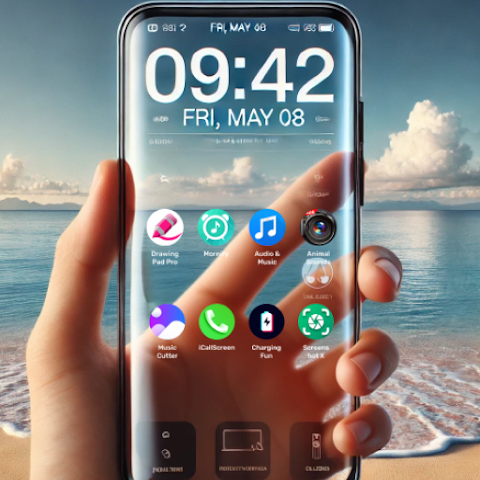Transparent Wallpaper — A Practical Guide for Designers and Users
What is transparent wallpaper?
Transparent wallpaper is an image or visual layer that includes transparency so that whatever is behind it is partially or fully visible. In practice, that means using image formats that support an alpha channel. Designers use transparent wallpaper to let desktop themes, widgets, or live wallpapers show through. On the web, transparent wallpaper is often used as a decorative overlay or hero background that blends with the page background color or video.
Why use transparent wallpaper?
- Minimal aesthetic: Transparency instantly lightens a composition and reduces visual clutter.
- Depth and layering: You can create the feeling of depth by stacking semi-transparent layers.
- Branding flexibility: A transparent logo or motif works on multiple color backgrounds.
- Performance: Small PNGs or optimized WebP images with transparency can be lighter than full-screen compressed photographs.
Common uses
- Phone lock screens and home screens with transparent overlays.
- Desktop wallpapers where the taskbar or widgets remain visible.
- Website hero sections that use a transparent PNG or SVG over a gradient or video.
- App backgrounds or splash screens that blend with device UI colors.
Best file formats for transparent wallpaper
Choose the format that fits your needs:
- PNG — The classic choice. Full alpha channel support and wide compatibility. Best for simpler images, icons, and logos.
- WebP — Modern and efficient. Supports alpha and offers better compression than PNG in many cases. Supported on most modern browsers and devices.
- SVG — Vector format. Ideal for logos, simple shapes, and patterns that need to scale without quality loss. SVG can also include CSS or filters for dynamic effects.
- APNG — If you want an animated image with transparency, APNG supports animation and alpha but has limited usage outside the web.
How to create a transparent wallpaper
Here is a simple workflow using common tools.
Step 1: Choose your canvas
Pick the target resolution. For mobile, common sizes are 1080×1920 or 1170×2532 depending on device. For desktops, choose at least the most common screen widths you want to support. If you plan responsive use, create multiple sizes.
Step 2: Work with layers
Use an image editor that supports layers and alpha channels. Examples include Photoshop, Affinity Photo, GIMP, or Figma. Create a transparent background layer. Add shapes, logos, gradients, or subtle textures on top. Keep heavy details near the center if the edges will be occluded by icons or widgets.
Step 3: Save with alpha
Export as PNG or WebP with an alpha channel. If you use SVG, make sure the background is not set — use fill="none" or transparent areas where required. Optimize the output with a lossless or lossy compressor depending on your quality needs.
Design tips for transparent wallpaper
- Contrast matters: If your overlay will sit on different backgrounds, test it on light and dark backgrounds to ensure readability of icons and widgets.
- Keep it simple: Small, subtle elements work better than busy patterns because device icons and widgets can clash visually.
- Edge safe zones: Avoid placing important visual elements too close to edges where system UI might hide them.
- Use semi-transparency: 10 to 40 percent opacity often gives the best balance between visibility and letting the background show.
How to set transparent wallpaper on devices
Android
1. Save the PNG/WebP to your phone. 2. Long tap the home screen and choose Wallpapers. 3. Pick the saved image and set as Home or Lock screen. For some launchers you may need to set the image as a widget background or use a dedicated live wallpaper app that supports transparency.
iPhone
iOS handles transparency differently. PNG transparency will show when used within apps, but for lock or home screen wallpapers, iOS typically flattens backgrounds. You can use semi-transparent overlays in widgets or app backgrounds, but expect the system to render wallpapers as flattened images. Test your design on an actual iPhone to check how transparency appears.
Windows
Windows treats wallpapers as flat images. You can set a PNG with transparent regions, but the system will show the desktop background color behind it. To achieve layering, use a widget or rainmeter skin that reads PNGs with transparency.
macOS
macOS also flattens wallpapers for the desktop. Use transparent PNG for app or window overlays. For desktop widgets or third-party apps that accept PNGs, transparency will work.
Using transparent wallpaper on the web
Transparent images are great on the web because they help you layer content. Here is a simple HTML + CSS snippet that demonstrates a transparent wallpaper overlay on a hero section.
By using pointer-events:none and an opacity value, the transparent wallpaper overlays the background without interfering with interaction.
Performance and optimization
- Compress smartly: WebP often offers better size for images with transparency. For PNGs, use pngquant or zopflipng for smaller files.
- Resize for target devices: Avoid shipping huge images to mobile. Provide multiple sizes and use responsive
srcsetfor web images. - Lazy load: For pages with multiple layered images, lazy load noncritical overlays so they do not block rendering.
Accessibility and contrast
Transparent wallpaper can reduce contrast between icons or text and the background. Always test contrast to ensure legibility. Use ARIA attributes and provide alternative text for decorative overlays. If the overlay carries important content, make sure that content is also available as text so screen readers can access it.
Examples and ideas
- Subtle brand watermark in the center with 20 percent opacity for an app splash screen.
- Geometric shapes with transparent holes that reveal a background gradient or live video beneath.
- Seasonal overlays: a faint snowflake pattern saved as a transparent PNG used only for December promotions.
Checklist before publishing
- Test on dark and light backgrounds.
- Export required sizes and formats (PNG, WebP, SVG where appropriate).
- Compress and measure file sizes.
- Verify accessibility and contrast.
- Provide clear alt text or mark decorative images with
role="presentation".
Conclusion
Transparent wallpaper is a powerful tool. It gives you flexibility to layer visuals, keep designs minimal, and adapt to many devices. The right file format, careful contrast testing, and moderate opacity will make your transparent wallpaper feel polished and functional. Whether you are building a phone theme, a desktop skin, or a website hero section, following the steps in this guide will help you create transparent wallpapers that look great and perform well.
Quick tip: When in doubt, export both PNG and WebP versions and test both. Some older devices prefer PNG while most modern browsers and devices benefit from WebP compression.







